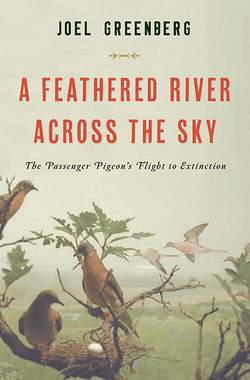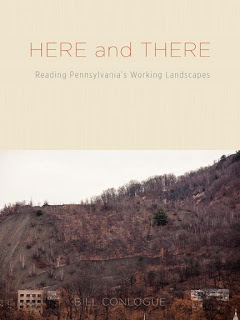
Growing up, I knew of the passenger pigeon -- it was the poster child (or poster animal?) speaking out against extinction. Martha, the last passenger pigeon, was pictured in our fourth grade science textbook as a warning about what the world could do to animals, and I remember staring at the photo and thinking of the mourning doves that cooed outside my bedroom windows and wondering if they could also become extinct.
I am reminded of the passenger pigeon in other ways as well. On my way to my brother's house in Forest County, Pennsylvania, I pass through a small village named Pigeon, so named because of the large flocks of passenger pigeons that once flew through the area.
Still, I didn't really know anything about the passenger pigeon until I read Joel Greenberg's A Feathered River Across the Sky: The Passenger Pigeon's Flight to Extinction. Through concise and thorough research, Greenberg chronicles the world of the passenger pigeon, from the times when flocks blocked out the sun to the sky to the death of Martha, in 1914.
Greenberg starts off his book by explaining the life of this important bird: "At the time of that Europeans first arrived in North America, passenger pigeons likely numbered anywhere from three to five billion. It was the most abundant bird on the continent, if not the planet, and may well have comprised 25 to 40 percent of North America's bird life." Numbers, of course, don't necessarily paint a picture for the reader, but then Greenberg goes on to present a vivid image of the population of the passenger pigeon: "Famed naturalist John James Audubon recorded a pigeon flight along the Ohio River that eclipsed the sun for three days."
It seems hard to believe that a bird that commanded such a presence could become extinct at the hands of humans. But it did. Greenberg spends chapters detailing the complex relationship of the passenger pigeon to Americans. Not only does he describe the different ways mankind killed the passenger pigeon, but he also records their defenders, those who studied and/or celebrated the bird's presence. Furthermore, he includes a chapter that reports the last great nesting sites -- many in northern Pennsylvania.
Of course, no book about the passenger pigeon would be complete without the role of Martha, the last passenger pigeon who died in the Cincinnati Zoo in 1914. Martha had not been the only passenger pigeon at the zoo; however, as Greenberg explains, "As the passing years took their toll, she watched the members of the flock slowly disappear." Indeed, Greenberg goes on to explain, "It is easy to become anthropomorphic about Martha's situation as the idea of impending aloneness so absolute is heartrending."
Greenberg wraps up his book with a chapter titled "Extinction and Beyond" that not only explores the rumors of passenger pigeons after Martha's death, but also outlines other animals that are endangered and/or threatened. It's a chapter that is especially interesting to me, as he mentions the slow demise of America's Little Brown Bat, a mammal that once commanded the small town Pennsylvania skies at dusk. At one time, I would see hundreds of bats in the twilight skies. This year, I have seen one.
At the Roger Tory Peterson Institute's 2014 Bird Fest, I had the pleasure of meeting Joel Greenberg. While I didn't get to hear his formal talk, he did go on one of the same bird walks I did, (see the blog post that details exactly what we saw) and we had the chance to chat briefly about nature writing, Aldo Leopold (his favorite!) and Barbara Hurd (one of my favorites!). For more information about Greenberg and his work, see his homepage.
I am reminded of the passenger pigeon in other ways as well. On my way to my brother's house in Forest County, Pennsylvania, I pass through a small village named Pigeon, so named because of the large flocks of passenger pigeons that once flew through the area.
Still, I didn't really know anything about the passenger pigeon until I read Joel Greenberg's A Feathered River Across the Sky: The Passenger Pigeon's Flight to Extinction. Through concise and thorough research, Greenberg chronicles the world of the passenger pigeon, from the times when flocks blocked out the sun to the sky to the death of Martha, in 1914.
Greenberg starts off his book by explaining the life of this important bird: "At the time of that Europeans first arrived in North America, passenger pigeons likely numbered anywhere from three to five billion. It was the most abundant bird on the continent, if not the planet, and may well have comprised 25 to 40 percent of North America's bird life." Numbers, of course, don't necessarily paint a picture for the reader, but then Greenberg goes on to present a vivid image of the population of the passenger pigeon: "Famed naturalist John James Audubon recorded a pigeon flight along the Ohio River that eclipsed the sun for three days."
It seems hard to believe that a bird that commanded such a presence could become extinct at the hands of humans. But it did. Greenberg spends chapters detailing the complex relationship of the passenger pigeon to Americans. Not only does he describe the different ways mankind killed the passenger pigeon, but he also records their defenders, those who studied and/or celebrated the bird's presence. Furthermore, he includes a chapter that reports the last great nesting sites -- many in northern Pennsylvania.
Of course, no book about the passenger pigeon would be complete without the role of Martha, the last passenger pigeon who died in the Cincinnati Zoo in 1914. Martha had not been the only passenger pigeon at the zoo; however, as Greenberg explains, "As the passing years took their toll, she watched the members of the flock slowly disappear." Indeed, Greenberg goes on to explain, "It is easy to become anthropomorphic about Martha's situation as the idea of impending aloneness so absolute is heartrending."
Greenberg wraps up his book with a chapter titled "Extinction and Beyond" that not only explores the rumors of passenger pigeons after Martha's death, but also outlines other animals that are endangered and/or threatened. It's a chapter that is especially interesting to me, as he mentions the slow demise of America's Little Brown Bat, a mammal that once commanded the small town Pennsylvania skies at dusk. At one time, I would see hundreds of bats in the twilight skies. This year, I have seen one.
At the Roger Tory Peterson Institute's 2014 Bird Fest, I had the pleasure of meeting Joel Greenberg. While I didn't get to hear his formal talk, he did go on one of the same bird walks I did, (see the blog post that details exactly what we saw) and we had the chance to chat briefly about nature writing, Aldo Leopold (his favorite!) and Barbara Hurd (one of my favorites!). For more information about Greenberg and his work, see his homepage.

 RSS Feed
RSS Feed
